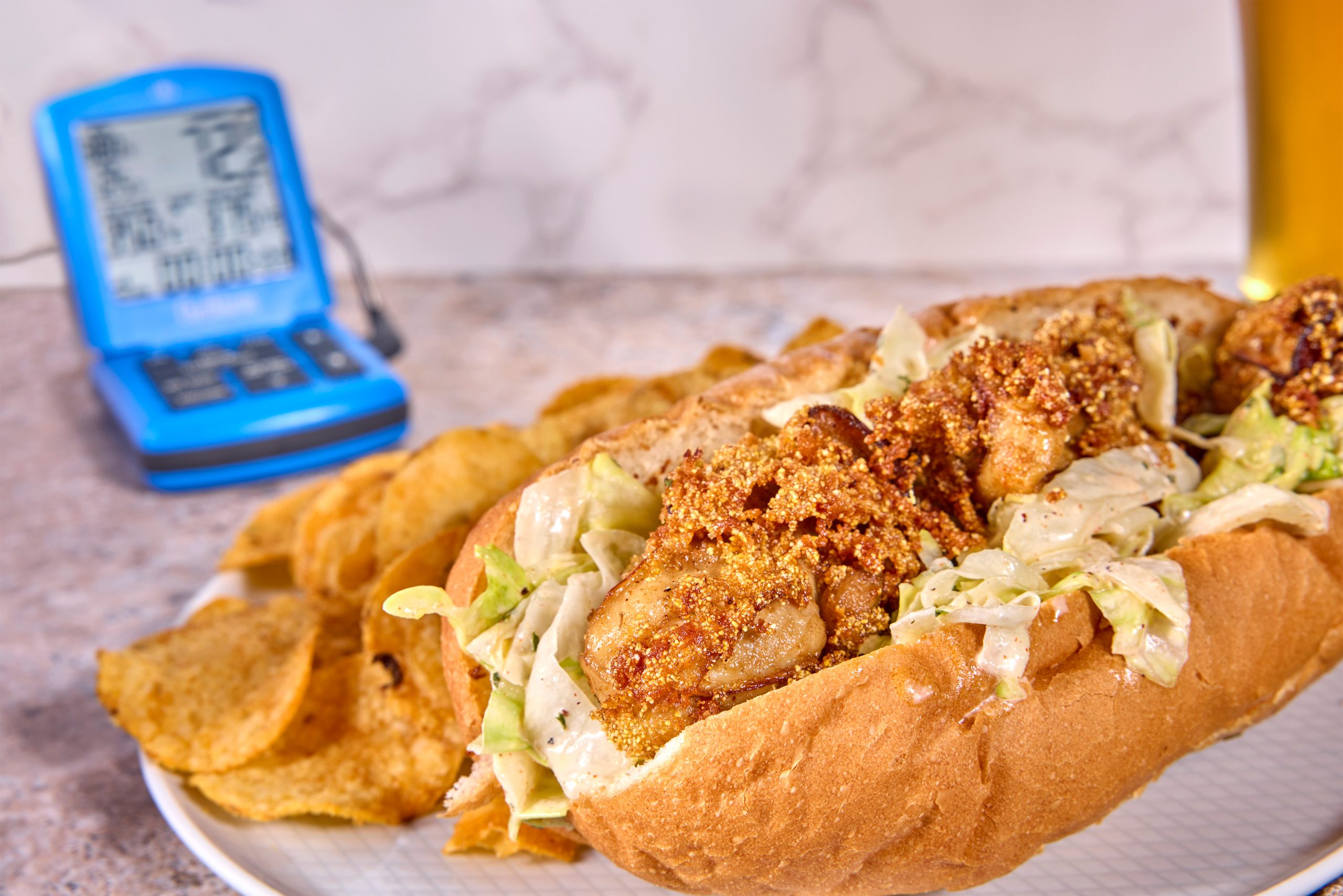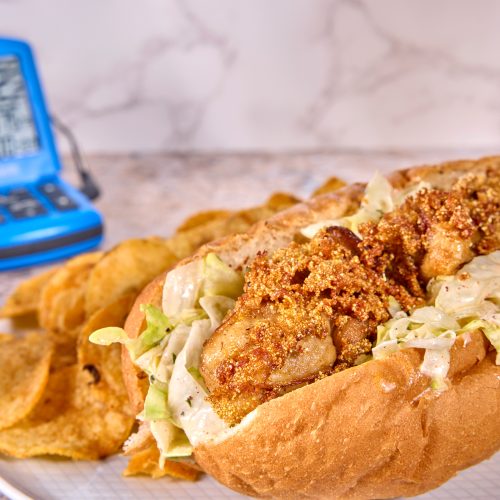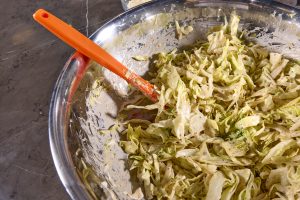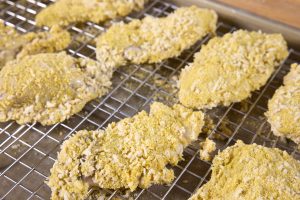Oyster Po Boy Sandwich: Temps for a Superb Sandwich
We’re big sandwich fans, as you know (see: rye sandwich bread, spicy chicken sandwich, and our recently revamped roast beef). So we’re always keen to find ways to bring our thermal expertise to classic sandwiches. And today we’ve got a great one: the New Orleans oyster po-boy! A well-beloved sandwich with a storied history, the oyster po-boy is a delicious blend of textures and of flavors that is well worth a try.
Here we’ll talk about the thermal principles involved in making this sandwich, and provide you with an adaptation of Alton Brown’s stellar version. Let’s get cooking!
Get the temperature tool you need for this cook:
Background: terminology, history, spread, and lore of the oyster po’ boy sandwich
Frist, we can state the obvious and say that the oyster po-boy (po’ boy, po boy, po-boy, poor boy) is a po’boy sandwich. The po’boy sandwich hails from Louisiana, where the accent stripped the “r” from the “poor.” Po’boys are sandwiches, most often with meat fillings, made on soft New Orleans French bread. You can’t have a po’boy between two slices of rye—that’s a different sandwich—nor can you have it on an authentic French baguette. Po’boys are often simply dressed with lettuce, and perhaps sliced tomato and pickle with no fancy toppings.
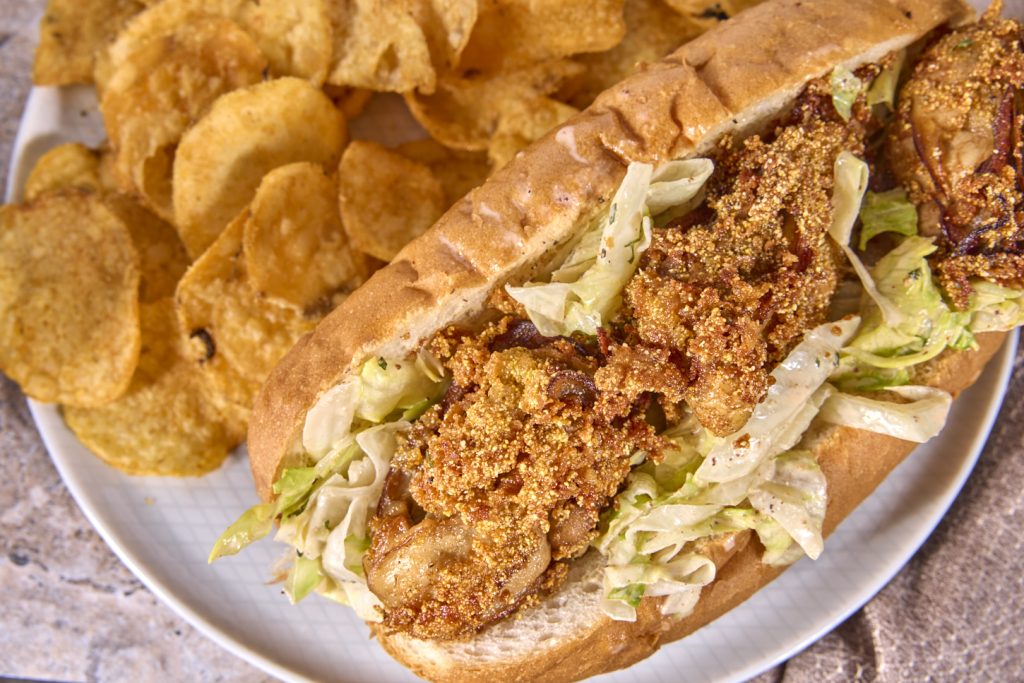
The oyster po’boy is also known regionally as an “oyster loaf,” a reference to the French bread on which it is built, not the cooking method of the oysters. This sandwich has roots that go back to the late 1800’s in New Orleans, where, for generations, it was often brought home from bars by husbands seeking to regain favor with their wives after staying out with their comrades for too long. When thus applied, it was known as a “peacemaker” sandwich or “La Mediatrice”.
Of course, the sandwich was at home on the Gulf Coast with its rich and fertile waters, but the tradition also traveled west and took root in the colder waters of the San Francisco Bay. There, oyster loaves were also enjoyed and also used to buy forgiveness from neglected spouses.
What is an oyster loaf/oyster po boy?
As is true with all po’boy sandwiches, the oyster po’boy is simply dressed, simply made. There is the bread: soft, but with a little crisp on the crust. A good-quality hoagie bun will do, as long as it has a little body to its crust. Then there is the lettuce. Shredded is common, and in our case, we dress that lettuce with a sauce of mayonnaise, lemon juice, and spices. Then, of course, there are the oysters which are shucked, marinated in buttermilk, then dredged in corn meal and breadcrumbs before being fried. You can certainly add some sliced tomato, and we’d never skip a dash or two of New Orleans-style hot sauce, as well.
How to fry oysters
Oysters are often eaten raw, freshly shucked on the half shell or taken with a little sauce in a shooter. There are exceptions, of course. They are also grilled, cooked in the shell until the top opens and the smoke of the grill gets in the liquor inside. Or they are coated in a rich sauce and broiled in the style of oysters Rockefeller. In neither of those cases is the oyster usually fully “cooked,” and the same is true with fried oysters.
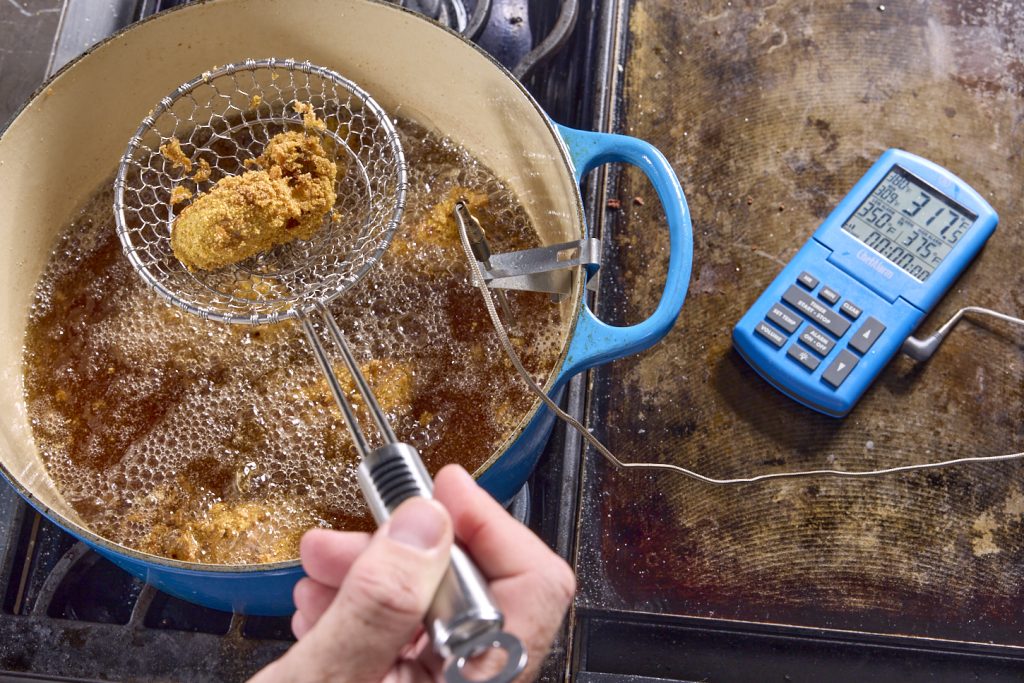
Our primary concern when frying oysters is the breading itself. We want it to be toasty, crisp, golden brown, and delicious. What about the doneness temp of the oysters themselves? Well, as we usually open them up and swallow them down, cooking them thoroughly really doesn’t matter, does it? So oil temp is what really matters here.
Oil temp for frying oysters
To get a quick, crisp fry on the oyster breading, we need our oil a little hotter than we do for, say, fried chicken. In that case, we have to sure about cooking the chicken through, but not here! Use your ChefAlarm (the best deep-fry thermometer there is) to monitor the oil temp and run it at 375°F (191°C). Set the high-temp alarm for that temperature and the low-temp alarm for 350°F (177°C). When you add the oysters, which are very wet, to the oil, the temperature will plummet, so be ready to turn the heat up on your stove as soon as they hit the oil. Using more oil in the pot will help maintain the heat reservoir without draining all the energy off in steam-heat.
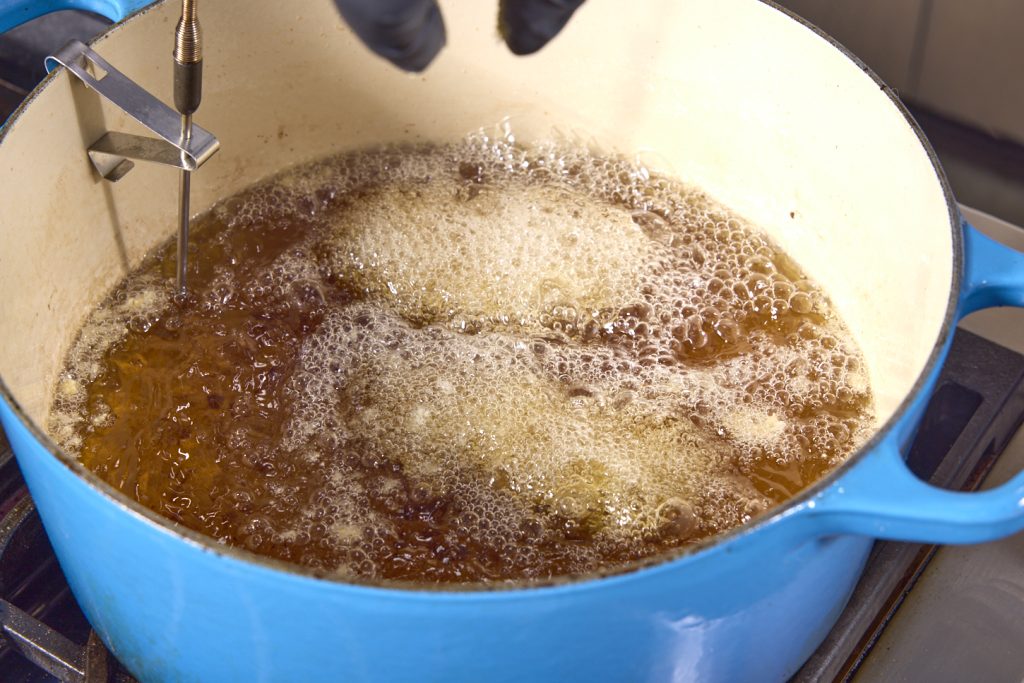
Cook 4–6 oysters at a time, allowing the temperature to completely recover in the pot before adding the next batch.
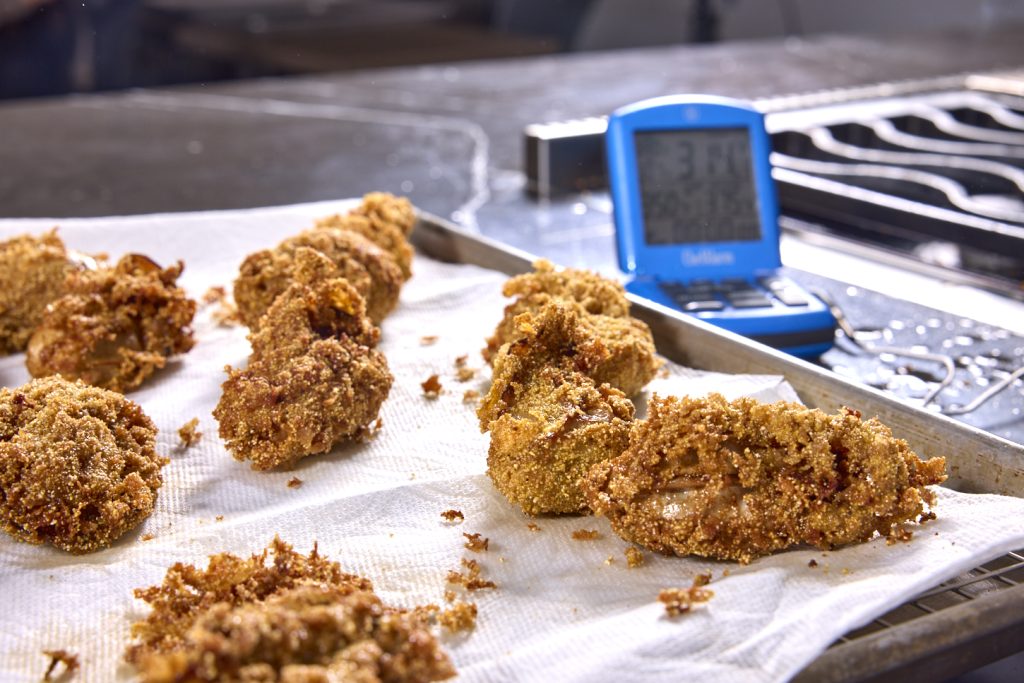
If you want to try this fascinating and delicious sandwich, get yourself some fresh oysters, shuck ’em out, and give it a shot. Use your ChefAlarm to maintain your oil temperature properly, and throw one together. You don’t need to be seeking reconciliation to enjoy this New Orleans classic! Happy cooking!
Oyster Po’Boy Sandwich Recipe
Ingredients
For the slaw
- ½ C mayonnaise
- 4 tsp fresh-squeezed lemon juice
- 1 Tbsp Dijon mustard
- 1 Tbsp hot sauce
- 2 tsp pickle brine
- ½ tsp kosher salt
- ½ tsp dried parsley
- ¼ tsp garlic powder
- ¼ tsp black pepper
- ¼ tsp sumac
- ¼ tsp cayenne
- 1 small head iceberg lettuce, shredded
For the oysters
- ½ C buttermilk
- 2 tsp hot sauce
- 24 each fresh oysters, shucked U.S. farm-raised oysters are the best thing to use here
- 1 qt peanut oil
- ¾ C fine corn meal
- ¾ C panko breadcrumbs
- 1 ½ tsp kosher salt
- 1 tsp fresh-grated nutmeg
- fresh-ground black pepper, to taste
For the sandwich
- 4 each 6–8" French bread rolls
Instructions
Make the slaw
- Combine the mayo, lemon juice, and all other slaw-dressing ingredients in a bowl.
- Add the shredded lettuce, toss to combine, and place in the fridge until ready to use, about 30 minutes.
Prepare the oysters
- Combine the buttermilk and hot sauce in a bowl.
- Add the oysters and let them marinate 30–60 minutes.
Fry the oysters and make the sandwich
- Heat the peanut oil in a dutch oven or a heavy pot. Use your ChefAlarm to monitor the temperature, setting the high-temp alarm for 375°F (191°C) and the low-temp alarm for 350°F (177°C).
- While the oil heats, combine the cornmeal, bread crumbs, salt, and nutmeg in a shallow bowl.
- Remove one oyster at a time from the milk bath, draining off excess moisture, and dredge it in the cornmeal/breadcrumb mixture. Set it on a rack set into a cookie sheet.
- Repeat with all the oysters.
- When the oysters are all breaded, start frying. Put 4–6 oysters into the pot of oil at a time and cook until just golden brown, about 1½–2 minutes. Keep an eye on the oil temp on your ChefAlarm!
- Move the fried oysters to a rack lined with paper towels and sprinkle with black pepper.
- Repeat the frying for all the oysters, letting the temperature in the pot recover to 375°F (191°C) between batches.
- Cut the rolls nearly in half, open them, and pull a little of the bread out of the belly of the bread to accommodate the oysters. Place 6 oysters in each roll and top with about a half cup of the lettuce slaw.
- Serve, passing more hot sauce at the table is you like.


